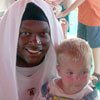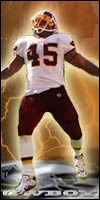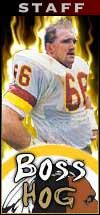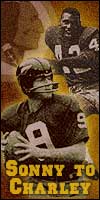Brandon777 wrote:Still dodging the "startle reflex" issue.
Startle Reflex
Neuro term. 1. A sudden, involuntary movement made in response to a touch, an unexpected motion, or a loud noise. 2. A set of automatic protective movements designed to withdraw the body and its parts from harm.
Usage: Many defensive postures and submissive gestures (e.g., diverse movements of the shoulder-shrug display) derive from paleocircuits of the mammalian startle. Its status as a reflex explains why human beings (in all cultures) a. blink and grimace; b. flex the neck, elbows, trunk, and knees; and c. elevate the shoulders when feeling physically, emotionally, or socially threatened (Andermann and Andermann 1992:498).
Media. Eccentric twisting, plunging, blinking, and flexing spasms made from 1989-98 by Seinfeld TV character, Cosmo Kramer are typical of people with an exaggerated startle response. Increasing with anxiety and fatigue, the startle underlies such culturally recognized "startle syndromes" as Indonesian latah, Japanese imu, and Lapland's Lapp panic (Joseph and Saint-Hilaire 1992:487-8.
RESEARCH REPORTS: The startle reflex is related to the Moro or "clamping" reflex of young primates, which includes a. arm, leg, and spinal-column extension movements; b. head bowing (over the chest); and c. crying (McGraw 1943:19). Present in the human fetus after 30 weeks, the startle is predominantly a flexor reflex, possibly rooted in the primitive orienting response (Joseph and Saint-Hilaire 1992:487).
Neuro-notes. Sudden movements, looming objects, or bright lights trigger midbrain optic centers which automatically turn our faces and eyes toward what could be dangerous--before the forebrain knows, on a conscious level, danger even exists. The midbrain's auditory lobes, meanwhile, are reflexively attuned to changes in sound. Located just below the optic-center lobes, these pea-sized areas control our auditory startle. Picked up by the cochlear nucleus, a scream received by the auditory lobes triggers the amygdala and circuits of the reticulospinal tract to activate the startle. Thus, recoiling from a karate yell, e.g., is a primal response prompted by paleocircuits of the amphibian brain.
See also CHATTERING TEETH, FLEXION WITHDRAWAL.
in·vol·un·tar·y (n-vln-tr)
adj.
Not subject to control of the volition.
Acting or done without or against one's will.
http://dictionary.reference.com/search?q=involuntaryThe cerebral cortex is a brain structure in vertebrates, including humans. It is the outermost layer of the cerebrum and has a grey color. The human cerebral cortex is 2-4 mm (0.08-0.16 inches) thick and is highly folded.
In the "higher" animals (especially the higher mammals), the surface of the cerebral cortex becomes folded. This creates grooves on the surface of the brain called "sulci" (singular = "sulcus"). The bumps or ridges on the surface of the brain are called "gyri" (singular = "gyrus"). The folding of the cortex increases the cortical surface area. The cerebral cortex, made up of four lobes, is involved in many complex brain functions including memory, perceptual awareness, "thinking", language and consciousness.
http://en.wikipedia.org/wiki/Cerebral_cortexThe brain stem carries out for the face the functions that the spinal cord carries out for the body. It receives sensory information from all senses (except olfaction [smell]) from the face, controls the muscles for the face, and organizes reflexes involving the face. Sensory pathways from the spinal cord to the cerebral hemispheres and motor pathways from the cerebral hemispheres to the spinal cord pass through it.
The brain stem also organizes many of the vital reflexes that manage the internal organs of the body, including heart beat, blood pressure, swallowing, stomach activity, etc. Because these reflex centers are located in the lower brain stem just inside the base of the skull, a sharp blow to the base of the skull can kill by disrupting these reflexes.
In addition, the brain stem has extra, specialized functions. It organizes complex reactions and co-ordinates many different reflexes, so that they work together smoothly. Examples of complex reflex reactions organized in the brain stem are the startle reflex and various balance reflexes. Many things, such as an loud sound, an unexpected touch or sound, etc., can elicit it. A startle reflex involves most of the body: the body, arms, and legs partially flex, neck jerks back, and the face shows a startled expression (partially opened mouth, eyes widened, etc.).
http://www.indiana.edu/~p1013447/dictionary/br_stem.htm
if i may speak for cville, it appears as if he's arguing that because terry's cerebral cortex (the part of the brain that is reponsible for thinking and awareness) had turned to liquid, she is brain dead; a permanent cessaction of brain activity. furthermore, just because the brain stem (the part of the brain that controls reflecive movements, including the 'startle reflex') was fully or partially functioning, this does not mean that terry was conscious in any way.
perhaps now we can put this 'startle reflex' issue to bed.


 ey-Aid of the Redskins.
ey-Aid of the Redskins.






